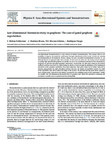
Please use this identifier to cite or link to this item:
http://ricaxcan.uaz.edu.mx/jspui/handle/20.500.11845/620Full metadata record
| DC Field | Value | Language |
|---|---|---|
| dc.contributor | 39945 | es_ES |
| dc.contributor.other | https://orcid.org/0000-0003-0087-8991 | - |
| dc.creator | Molina Valdovinos, Sergio | - |
| dc.creator | Martínez Rivera, Freddyson J. | - |
| dc.creator | Moreno Cabrera, Nadia E. | - |
| dc.creator | Rodríguez Vargas, Isaac | - |
| dc.date.accessioned | 2018-08-08T16:39:25Z | - |
| dc.date.available | 2018-08-08T16:39:25Z | - |
| dc.date.issued | 2018-07 | - |
| dc.identifier | info:eu-repo/semantics/publishedVersion | es_ES |
| dc.identifier.issn | 1386-9477 | es_ES |
| dc.identifier.uri | http://hdl.handle.net/20.500.11845/620 | - |
| dc.identifier.uri | https://doi.org/10.48779/y325-yb04 | - |
| dc.description.abstract | Low-dimensional thermoelectricity is a key concept in modern thermoelectricity. This concept refers to the possibility to improve thermoelectric performance through redistribution of the density of states by reducing the dimensionality of thermoelectric devices. Among the most successful low-dimensional structures we can find superlattices of quantum wells, wires and dots. In this work, we show that this concept can be extended to cutting-edge materials like graphene. In specific, we carry out a systematic assessment of the thermoelectric properties of quantum well gated graphene superlattices. In particular, we find giant values for the Seebeck coefficient and the power factor by redistributing the density of states through the modulation of the fundamental parameters of the graphene superlattice. Even more important, these giant values can be further improved by choosing appropriately the angle of incidence of Dirac electrons, the number of superlattice periods, the width of the superlattice unit cell as well as the height of the barriers. We also find that the power factor presents a series of giant peaks, clustered in twin fashion, associated to the oscillating nature of the conductance. Finally, we consider that low-dimensional thermoelectricity in graphene and related 2D materials is promising and constitutes a possible route to push forward this exciting field. | es_ES |
| dc.language.iso | eng | es_ES |
| dc.publisher | Elsevier | es_ES |
| dc.relation | https://www.sciencedirect.com/science/article/pii/S1386947717316053?via%3Dihub#! | es_ES |
| dc.relation.ispartof | https://reader.elsevier.com/reader/sd/9F58CDAC2097876809F9D6B28542B90EC7E30C11777F0D7CE96B5D5724AD9B3C290263550020AA367141CEC6419F45FE | es_ES |
| dc.relation.isreferencedby | Global | es_ES |
| dc.relation.uri | generalPublic | es_ES |
| dc.rights | Atribución-NoComercial-CompartirIgual 3.0 Estados Unidos de América | * |
| dc.rights.uri | http://creativecommons.org/licenses/by-nc-sa/3.0/us/ | * |
| dc.source | Physica E., Volume 101, July 2018, Pages 188-196 | es_ES |
| dc.subject.classification | CIENCIAS FISICO MATEMATICAS Y CIENCIAS DE LA TIERRA [1] | es_ES |
| dc.subject.other | Thermoelectricity | es_ES |
| dc.subject.other | Graphene superlattices | es_ES |
| dc.subject.other | Seebeck coefficient | es_ES |
| dc.subject.other | Ballistic transport | es_ES |
| dc.title | Low-dimensional thermoelectricity in graphene: The case of gated graphene superlattices | es_ES |
| dc.type | info:eu-repo/semantics/article | es_ES |
| Appears in Collections: | *Documentos Académicos*-- UA Física | |
Files in This Item:
| File | Description | Size | Format | |
|---|---|---|---|---|
| 1-s2.0-S1386947717316053-main.pdf | 1,06 MB | Adobe PDF |  View/Open |
This item is licensed under a Creative Commons License
